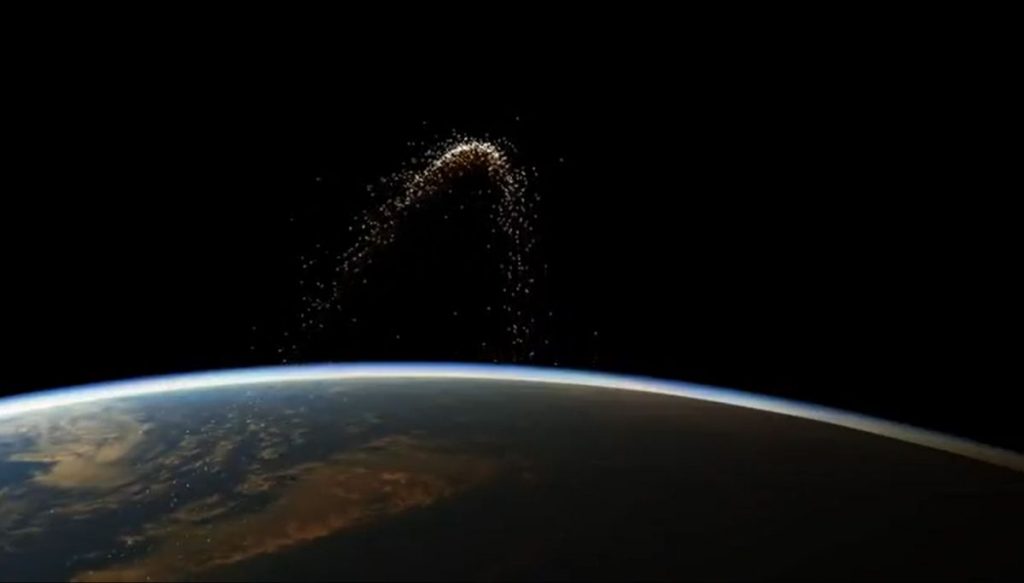
New space arms race could hinder exploration efforts (Image Credit: Space.com)
For some space watchers, Nov. 15, 2021 brought a glimpse of a very dark future.
On that date, Russia launched an unannounced missile that shattered one of its own defunct satellites into myriad shards, including over 1,000 pieces large enough to track. The rain of debris sent the International Space Station crew — including two Russian cosmonauts — scrambling into their transports for shelter. The detritus continued to circle; months later, one piece passed within (opens in new tab) a dangerous stone’s throw of a Chinese Earth-observation satellite.
One month later, 163 countries in the United Nations General Assembly voted (opens in new tab) to create a working group to stave off a space arms race. As that working group now gathers in Geneva, its members face an unsettling problem: the growing weaponization of space poses a threat to human spaceflight in more than one way.
Related: The worst space debris events of all time
The most common satellite-smashers in the world’s imagination are likely physical kinetic weapons — missiles, for instance, that cause damage by crashing into their targets at high speed. Russia’s 2021 test might have been the highest profile of that type, but it was far from the first: the U.S. and the Soviet Union both developed anti-satellite missiles during the Cold War.
And more recently, in 2008, the US shot down (opens in new tab) one of its own reconnaissance satellites, ostensibly to stop its toxic hydrazine fuel from falling to Earth’s surface. In 2007, China blasted an old weather satellite out of a polar orbit. In 2019, India tested an anti-satellite missile system of its own. Russia’s 2021 test only adds to this growing litany.
Blowing up satellites in orbit can create a potpourri of space debris. Sometimes, it can fall back into Earth’s atmosphere and harmlessly burn up. Other times, it can circulate for years. Shards of the 2007 Chinese incident still threaten satellites today.
“I don’t think people will actually target humans in space, but the debris aspect is quite dangerous,” Makena Young, an analyst at the Center for Strategic and International Studies (CSIS), a think tank in Washington D.C., told Space.com.
Young and her colleagues at CSIS classify space weapons (opens in new tab) into four kinds, and physical kinetic weapons are just one of them.
A second category, “non-physical kinetic weapons,” includes high-altitude nuclear detonations or anti-satellite laser weapons. The former are banned by the 1963 Partial Test Ban Treaty (although nuclear powers China and North Korea have never signed the treaty). Lasers, on the other hand, have no such restriction. The U.S (opens in new tab)., Russia and China (opens in new tab) are all reportedly developing anti-satellite lasers.
CSIS’s third and fourth categories might seem less tangible: electronic and cyber attacks involving satellites. That might involve jamming GPS signals or “spoofing” them to alter an object’s apparent location — both of which Russia has been accused of doing in its ongoing invasion of Ukraine. But analysts worry (opens in new tab) that such attacks could escalate into disabling satellites.
Today, as the world’s space powers plan to send humans to the moon and beyond, they may be seeing the threats. Despite China’s tightening relations with Russia, Chinese officials were unimpressed when Russian-caused debris threatened their satellites. And the U.S. was one of the major drivers behind the current UN working group.
“I think, when it comes to human spaceflight and longer-term missions that countries are spending more money getting together,” said Young, “there certainly is more risk involved, and they want to mitigate that risk.”
Follow us on Twitter @Spacedotcom (opens in new tab) or on Facebook (opens in new tab).





